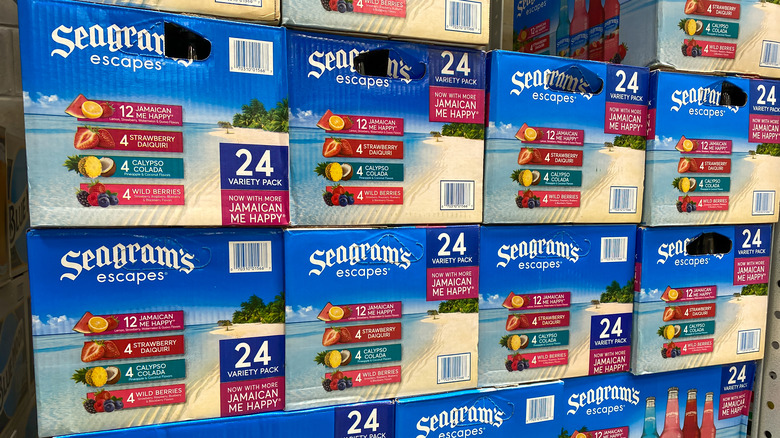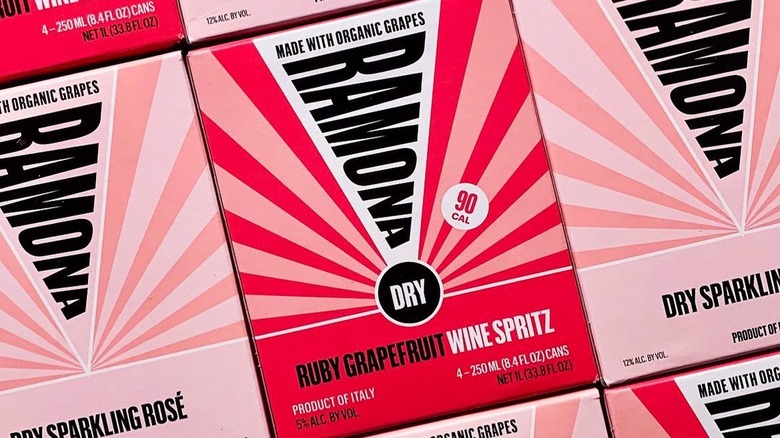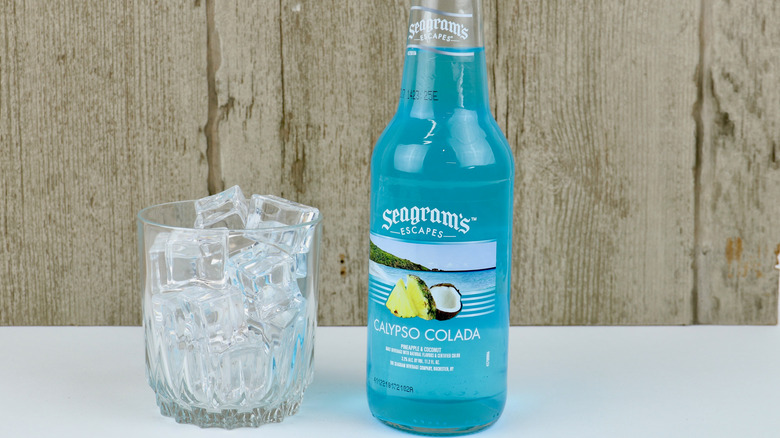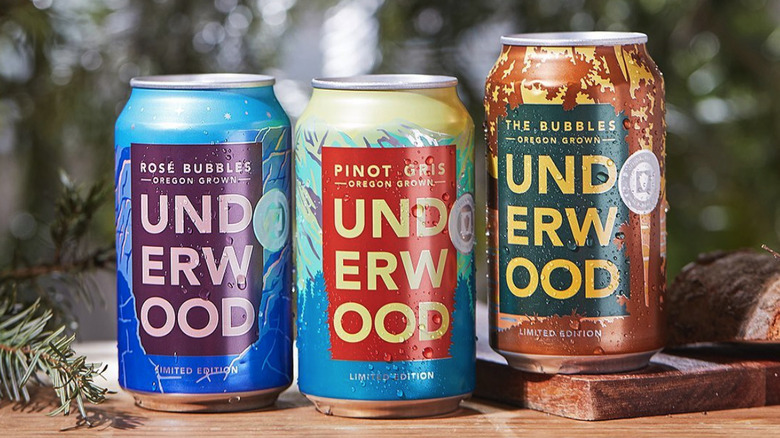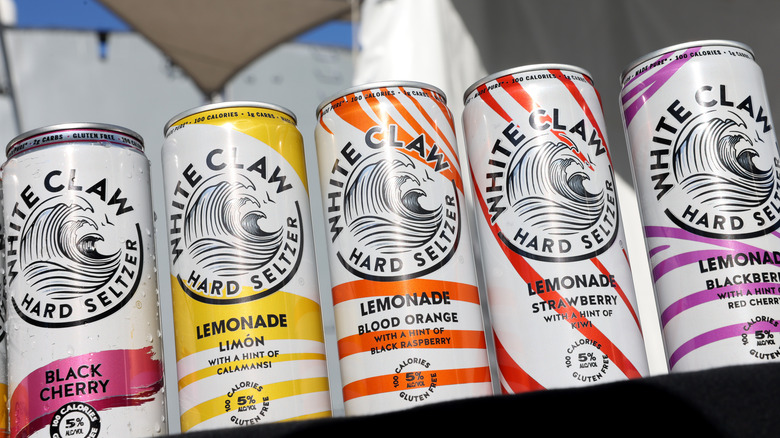Wine Coolers Are The Nostalgic Libations That Deserve A Boozy Comeback
Wine coolers in the 80s and 90s had a reputation for being generally awful. They reflected the neon fever dream of the era, and were cheap, cheerful, and led to terrible hangovers. With names like Fuzzy Navel, Jamaican Me Happy, and Calypso Colada it's rather easy to see why these often scorned drinks faded out of the cultural zeitgeist.
But nostalgia is in, and along with the slip dresses and fanny packs come the wine coolers. Those fluorescent, fizzy, sugary drinks you used to sneak out of the refrigerator when your friends spent the night are having a well-deserved — yet classy and understated — comeback. Gone are the vivid colors and questionable ingredients like red dye 40 and super cheap, poor-quality wines. Instead, companies are focusing on quality, natural ingredients, low sulfites, elegance, and plenty of refreshment. The revival comes on the heels of the popularity of low-alcoholic drinks like hard seltzers and canned spritzers and cocktails — the perfect antidote to a hot summer day.
Wine coolers and spritzers are easy drinking
Wine coolers and spritzes are generally considered easy to drink because of their low alcohol value and high sugar content. When wine coolers first came on the scene in the 80s, they were made by a couple of California entrepreneurs who tested them at pool parties in their yards. The original idea was that they would be simple and classic, made with the cheap, light white wine like pinot grigio and chablis, that was available in abundance at the time, and mixed with fruit juices and a dash of soda. When the big beverage companies took over, the struggle to stand out amidst the competition, coupled with less wine availability, led to the sugary, artificial, low-quality drinks we remember best today.
Nowadays, we're seeing a return to the original idea of a simple, fun beverage, but with a huge increase in quality and sophistication. Today's wine coolers use natural fruit flavors, sometimes pulp, and high-quality wine. Independent wine drink makers are spearheading the push to create wine coolers and spritzers that appeal to more discerning tastes, featuring short ingredient lists and all-natural, organic wines and fruit juices. They're blending rosé wine and lemonade into an ultra-refreshing spritzer, or sourcing high-quality organic wines from Sicily and blending them with organic fruit juices like grapefruit, blood orange, and Meyer lemons. These drinks are still fun and casual, but the blend of flavors is meant to appeal to wine drinkers, not hide the flavor of the wine.
At one point, wine coolers were one of the most popular alcoholic drinks in the U.S.
Wine coolers were first sold in 1981, and by 1985 they were making up 10 percent of all the wine sales in the U.S., eventually raking in a billion dollars annually, and accounting for 20 percent of all wine drunk in the U.S. at their peak in 1987. Popular brands were California Coolers, Bartles & Jaymes, and Seagram's and they were marketed as an adult soda. And adults saw them as casual, drinkable, and fun: a little slice of sunny California beach life, wherever you happened to live. Their ubiquity and easy drinking led to their popularity amongst teenagers which corresponded with, and probably caused, a decline in their appeal to adults. By 1991, 35 percent of all coolers sold in the U.S. were drunk by high schoolers.
Eventually, the government had the final say on wine coolers. Manufacturers floundered when the tax on wine jumped from $.17 per gallon to $1.07 per gallon in 1991 and all of a sudden buying wine coolers got a lot more expensive. This led to brands nixing wine in favor of cheaper, lower-taxed malt liquor, which ushered in 90s mainstays Zima and Smirnoff Ice.
Look for wine coolers at your local liquor store
You can find the new, more bougie wine coolers and spritzers, with their hip pastel can art, popping up on grocery and liquor store shelves all over the country. If you live in a state where liquor can be sold in grocery stores like Arizona, Missouri, and the Dakotas, you might be able to find them in the beverage section. But since these drinks are meant to appeal to people who actually enjoy the taste of wine and not to kids looking for a quick buzz, you might have to find your wine coolers at a more discerning liquor store.
You can also order them online. A lot of the new wine cooler and spritzer brands such as Union Wine Company, Ramona, and Roseade also have their own online storefronts where you can purchase their fizzy refreshments. You can even find Ramona at Whole Foods stores nationwide. The prices, naturally, reflect the increased quality of ingredients, and you can get a four pack of the more sophisticated modern version in the range of $15 to $28.
It's a wide, confusing world of drinks that are all pretty much the same thing
There are multiple names for bubbly wine-based drinks, such as cooler and spritzer, but don't confuse them with hard seltzers, malted beverages, and other canned cocktails, though the recent popularity of these drinks opened the door for the comeback of wine coolers. A hard or spiked seltzer uses sparkling water mixed with liquor and some flavoring, and popular brands include White Claw Hard Seltzer or Truly. They're light and refreshing, but don't use wine as their alcohol element — in fact they have a malted alcohol base, making them the more sophisticated version of 90s malt-based fizzy drinks like Zima or Seagram's. On the other hand, you have canned cocktails such as Cutwater, which uses rum, vodka, and tequila for some of their cocktails, giving them a stronger alcoholic punch.
A wine cooler, for taxes, is a wine product. But, mixologists and brands alike mix and match terms for fizzy wine-based drinks — what you might call a spritzer might be someone else's cooler. And there are plenty of makers who prefer to call their wine coolers anything but — they're aiming for an elevated experience at a high-class wine bar rather than teenagers chugging them after their parents go to sleep. Whatever you call them, the decades-long history of wine-based drinks, with all of its ups and downs, proves that we're on a constant quest for a summery and refreshing libation.
